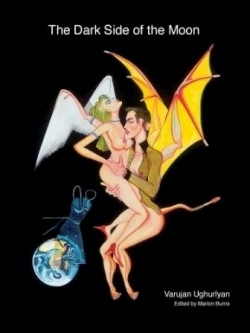The Dark Side of the Moon
Some people / Eventually may be appraised / By the value of the garbage / They collected on the way.
These poems and short-short prose pieces represent conversations with God, atoms, souls and grand existential issues. Subjects stressed are contact, duality, transformation and becoming. …I have found God and yet I am in quest of God everywhere…. The text was composed in Armenian and translated into English by Henrik Pipoyan. The Dark Side of the Moon combines celebration and freeform prayers of appeal. Readers are reminded that the fundamental status of being alive should generate amazement and reverence. Armenia suffered a genocide from 1915 through 1917. Descendants of the survivors don’t take breathing for granted. Life is precious, it is easily eclipsed. Question: To be or not to be? / Answer: To Be!
The oil paintings are predominately surrealist, with a nod toward Rene Magritte’s frames of disquieting contradictions—see the plates Choice, Palette and Internal Furnace. Themes involve creation, states of being, dream conditions, the divided person. Sub-themes are cosmological, concerning atoms, time, silences. Opportunities for discovery outpace available methods of validation. I have questions, / Irregularly stacked, / And I have / Possible fabricated answers. The central role of light is represented in forms of flame, candles, the sun. Egyptian deities appear. The powerful motif of artist-as-Christ figure recurs, as in The Anatomy of A Cross; style decisions in a few works lightly tip a hat to Orthodox iconography. The colors are rich and various. Ughurlyan does not commit to a particular scheme.
The more ambitious the project, the greater the risk that a bit of unevenness can creep in. In this case only a couple pieces don’t accomplish a noble creative purpose. The Catch features a man feeling up a mermaid in ocean surf, while a van-size spider-form hangs above them, possibly a space craft. Temptation, with a red and white bulls eye background sticks out in terms of composition, an isolated piece of pop art.
Varujan Ughurlyan was born in Yerevan, Armenia’s capitol city, when it was a component state of the U.S.S.R., but has resided in Los Angeles, California since 1990. This is his initial published work of paintings and poetry. Layout is classy but not elaborate, featuring large color plates and quality-sewn binding. Some images may be startling to the sensitive; this is free expression. The Big Questions rarely vary, but the means of investigation are constantly refined. Between the heartfelt words and provocative images, the poet-artist does all he can to serve up meaningful answers.
Disclosure: This article is not an endorsement, but a review. The publisher of this book provided free copies of the book and paid a small fee to have their book reviewed by a professional reviewer. Foreword Reviews and Clarion Reviews make no guarantee that the publisher will receive a positive review. Foreword Magazine, Inc. is disclosing this in accordance with the Federal Trade Commission’s 16 CFR, Part 255.

